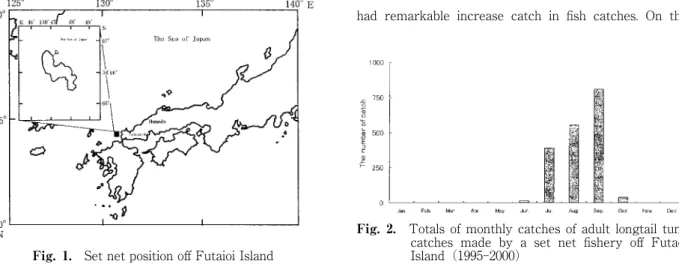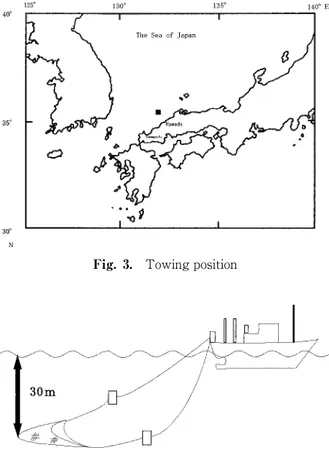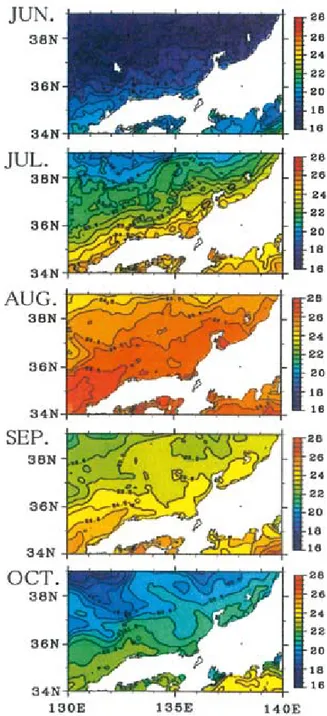Relation between catches of longtail tuna (Thunnus tonggol) and water
temperature off Futaoi Island, Shimonoseki City, Yamaguchi Prefecture
in the Sea of Japan based on catch data during the period 1995-2000
Masahiko Mohri
1, Koich Fukada
1, Harumi Yamada
2and Tadashi Kamano
3 Abstract : In recent years there has been insufficient study of longtail tuna, despite large harvests being recorded in the Sea of Japan. In the present study, therefore, we examine the relationship between longtail tuna catches and water temperature in the Sea ofJapan off the coast of Yamaguchi Prefecture. The results are as follows : I . The fishing season is from June to October. 2. We found from the study of juveniles caught by surface-water trawlling and oceanographic observation that : -Fork length ranged from 125 mm to 166 mm at the survey point. -Water ternperature was approximately 24℃ at the depth of the sampling position of longtail tuna juveniles. 3. Horizontal distribution of sea surface water temperature in 1996 was analyzed as follows using the NOAA satellite : -In July and September, adult longtail tuna were caught in abundance off the Futaoi Island, and the sea surface water temperature was as high as 24℃ around the set net position. -Temperature in August was above 24℃. -Temperature in October was below 24℃.Key words : tuna, water temperature, set net, trawl net
2009年6月30日受付.Received June 30, 2009.
1 Department of Fishery Science and Technology, National Fisheries University 2 Fisheries Agency, 1-2-1 Kasumigaseki, Chiyoda-ku, Tokyo 100-8907, Japan 3 Koyo Maru (training ship), National Fisheries University
Corresponding author : mmohri@fish-u,ac.jp
lntroduction
Eight tuna species are distributed around the world1).
In the Sea of Japan, bluefin tuna, Thunnus orientalis, are found in abundance2). ln addition, longtail tuna have often
been caught recently, although this species is a tropical tuna1).
In recent years, temperate longtail tuna have often been caught in the Sea of Japan. Nakamura3)reported that
many longtail tuna were caught with set nets in September in Wakasa Bay(northwestern part of Fukui Prefbcture), facing the sea ; but we identified the period June-October as the fishing season for the species off Futaoi Island, Shimonoseki City, Yamaguchi Prefbcture. Itoh et al.4)
tried to find the relationship between catch and water temperature at the fish catch point. But, they did not explicitly explaine condition factors such as when the longtail tuna catch was made, and the water temperature
corresponding to respective catch points. This is probably because the accuracies of fishing timing and corresponding water temperature of the catch points differed. Besides, Itoh et al.5)referred to the sea area of both adult and
young longtail tuna catches, but the remaining spawning areas still have not been identified in relation to longtail tuna.
In recent years, longtail tuna have not been treated as major components of the study, although large harvests can be observed in the Sea of Japan using a set net6). The
purpose of this study is to elucidate in detail the close relation off Futaoi Island in order to understand the ecology of longtail tuna in the Sea of Japan.
Materials and methods
During the years 1995-2000, the fishermen of Futaoi Island caught adult longtail tuna with a set net, and we
fishing season of adult longtail tuna caught by set nets to be from June to October, but with changes on a monthly basis. In July, the number caught exceeded 250, and the catch in September was the highest at about 800. From Kobayashi and Watanabe7), the species caught by a set
net off the Futaoi Island were considered to be mature fish and these individuals are of concern because of their spawning behavior.
Table1 represents the monthly average catches of adult longtail tuna in the years 1995-2000 by set net fishing off the island. As already explained(Fig.2), the fishing season ranged from June to October. But, on one hand, the fishing season was as long as four months in 1996. On the other hand, the fishing season was as short as two months in 1999. To explain the differences in fishing period by year, the significance of correlative relations between fish catch and water temperature is important. Referring to the year 1996, which had the longest fishing season and the larger longtail tuna catches, both July and September had remarkable increase catch in fish catches. On the identified the fishing season of the species. Then, we
sampled juveniles with a surface water trawl, and observed water tempemtures with a conductivity-temperature-depth device(CTD)at points for catching juveniles. We identified the horizontal distribution of water temperatures near the surface of the Japan Sea using the National Oceanic and Atmospheric Administration(NOAA) satellite of the USA,
Results and discussions
Fishing seasonFig.1 shows set net position off Futaoi Island. The set net was put in the area between 34° 06' N-134° 47' E, northeast of the island.
Fig.2 shows the monthly catches of longtail tuna obtained by a set net fishery off Futaoi Island(1995-2000). This figure in annual aggregate reflects the trend of the
Table 1. Monthly average catches of adult longtail tuna fished with a set net off Futaoi
Island in 1995-2000
Fig. 1. Set net position off Futaioi Island
Fig. 2. Totals of monthly catches of adult longtail tuna
catches made by a set net fishery off Futaoi Island(1995-2000)
other hand, catches declined in August and October. In 1996, we investigated the SST using the NOAA satellite. Juvenile longtail tuna and water temperature
Fig.3 is towing position and Fig.4 is a rough sketch of the towing method, respectrvely Between 35° 30' N-131°
00' E in September 1999, surface water trawling was carried out by Shunyo-maru, a research vessel of the National Institute of Far Seas Fisherles in Fisheries Agency of Japan. The surface water trawling net was towed at 5 knots at a depth of 0-30m from 19:50 to 20 :50.
Fig.5 shows a sample of juvenile longtail tuna collected by surface water trawling. Because the species were very small, it was impossible to identify them through morphological observations. Identification, therefore, was clarified by DNA analyses of Dr. Chow at the National Institute of Far Seas Fisheries.
Table2 shows the sampling data and sizes of longtail tuna juveniles in the waters of 35° 30' N・131° 00' E. These juveniles were found to range from 125 mm to 166 mm in fork length. These were srnall compared to the research of Itoh et al.5). The smallest among them was
considered to be within about one month after hatching.
Table 2. Seven juvenile longtail tuna investigated by DNA analyses Fig. 3. Towing position
Fig. 5. Sample of Juvenile longtail tuna Fig. 4. Schematic diagram oftowing method
Horizontal distribution of water temperature at the sea surface obtained by the NOAA satellite
Fig.7 depicts the horizontal distribution of water temperatures at the surface of the Sea of Japan obtained by the NOAA satellite of the USA in 1996. The year, as shown in Table 1, had both the largest catches and the longest fishing season of adult longtail tuna among the years 1995-2000. The water temperature near the sea This signifies that the catch positlon of adult mature
longtail individuals is near the survey point of the juvenile fish catch.
Fig.6 represents a vertical profile of water temperature at points for catching juvenile longtail tuna. This oceanographic observation by CTD was carried out concurrently at the same time and the same positions where samplings of longtail tuna juveniles were done. The water temperature of 24℃ that is predominant near the surface has a tendency to decline with water depth. Water temperature reaches almost 0℃ at the layers deeper than 125m. The water temperature measured was 24℃ at depths of 0-30m where longtail tuna juveniles were caught by a surface water trawl-net. The water temperature proved to be 24℃ at the distribution depths of juveniles. These surveys reveal that a water temperature of 24℃ is of special importance for habitats of longtail tuna juveniles.
Fig. 6. Vertical profile ofwater ternperatures at points
for catching juvenile longtail tuna off Futaoi
surface, where we put the set net, was in the range of 24℃ in July, exceeded that value in August, and was in the same range in September as in July. Water temperature fell below 24℃ in October. There were more catches of longtail tuna in July and September, so the two months had the optimum water temperatures and a better fishing season for species near the sea surface. This suggests that the optimum water temperature led to the better fishing season.
Conclusion
When we examined the close relation between catches of adult longtail tuna and water temperature of catch points off Futaoi Island(Shimonoseki City, Yamaguchi Prefecture)in the Sea of Japan, we clarified the following three points :
1.The fishing season of adult longtail tuna was the period June-October, particularly July and September ; 2.the level of 24℃, observed in July and September, was
the optimum water temperature for the juvenile species ; and
3.the NOAA satellite of the USA pointed out a close relationship between catches of the adult species and optimum water temperatures.
Acknowledgements
We are grateful to Dr. Chou at National Research Institute of Far Seas Fisheries for conducting the DNA analyses for this study. We are also grateful to Dr.
Morimoto at Nagoya University for providing us with invaluable information on water temperatures in the Japan Sea from the NOAA satellite ofthe USA.
References
1)Collette BB and Nauen CE : FAO species catalogue, Scombrid of the World, FAO, Rome(1983) 2)Okachi I : Studies on the distribution and structure of
the fish fauna in the Japan Sea by catch statistics, Ⅱ, Supplement of seasonal distribution and fishing condition ofthe bluefm tuna, Bull. Jap. Sea Reg. Fish. Res. Lab., 11, 9-21(1963)
3)Nakamura I : Big catches of longtall tuna in Wakasa Bay, Japan Sea, J of lchthyol., 15, 160-161(1969) 4)Itoh T, Tsuji S and Chow S : Longtail tuna catch
records and morphological changes with its growih in the neighborlng waters of Japan, Soc. Fish. Oceanogr., 60, 430-432(1996)
5)Itoh T, Yuki Y and Tsuji S : Spawning possibility and growih of longtail tuna, Thunnus tonggol, in the water around Japan, Bull. Nat. Res. Inst. Far Seas Fish., 36, 47-53 (1999)
6)Kobayashi T : Morphological differences between Thunnus tonggol and Thunnus thynnus on their young stage. Bull. Yamaguchi Pref. Fish. Res. Ctr., 2, 15-18(2004)
7)Kobayashi T and Watanabe T: Longtail tuna migrating along the Sea of Japan off the coast of Yamaguchi Prefecture, Bull. Seikai Brock Fishing and Oceanic Condition, 10, 15-20(2003)


